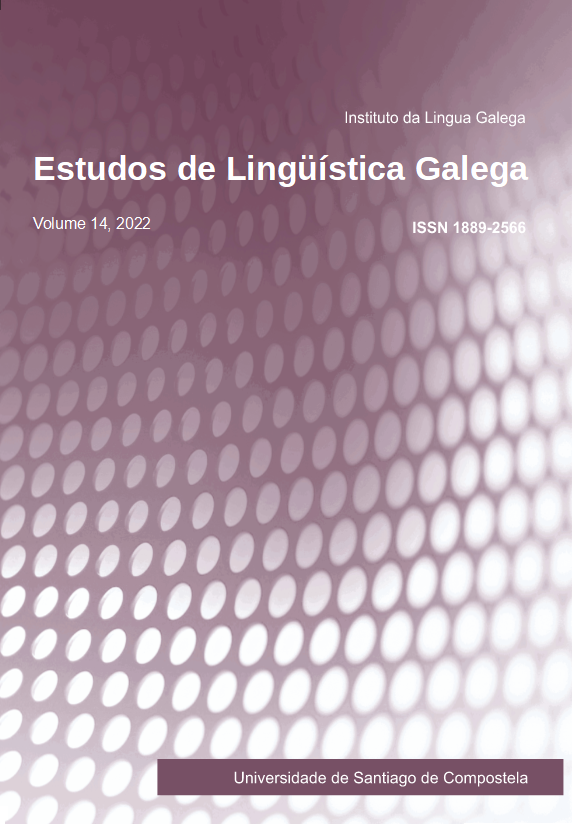Linguistic variation and distance in the Romania Antiqua: A dialectometric contribution to the debate about the degree of individuality of the Galician language
Main Article Content
Abstract
This paper presents a first dialectometric approach to the geolinguistic distribution of the Romance varieties using a new corpus based on the Atlas Linguistique Roman (ALiR) which is currently being developed at the Centro Ramón Piñeiro para a Investigación en Humanidades. The dialectometrization of the ALiR will not only allow us to analyze linguistic distance among the varieties of the Romania Antiqua, but may also shed light from a quantitative perspective on several issues that have historically aroused controversy. Specifically, this paper deals with the degree of individuality of the Galician language with respect to Portuguese and Spanish (a controversy closely related to the still on going debate about the standardization of Galician), and concludes that reinforcing the presence and visibility of elements shared with Portuguese in corpus planning may have a postive effect on its prestige.
Keywords:
Article Details
References
Alonso, Amado (1943): «Partición de las lenguas románicas de Occidente», en Joan Corominas (ed.), Miscel·lània Fabra. Buenos Aires: Coni, 81-101.
Contini, Michel (1992): «L’Atlas Linguistique Roman», IKER 7, 339-356.
Coseriu, Eugenio (1987): «El gallego y sus problemas. Reflexiones frías sobre un tema candente», Lingüística española actual 9, 127-138.
Diez, Friedrich C. (1836): Grammatik der romanischen sprachen. Bonn: E. Weber.
Elcock, William D. (1960): The Romance Languages. Londres: Faber & Faber.
Feldman, David (1974): «Consideraciones sobre la identificación lingüística de la lengua gallega», Grial 43, 38-48.
Fernández Rei, Francisco (1988): “Posición do Galego entre as linguas románicas”, Verba 15, 79-107.
Goebl, Hans (1991): “Dialectometry: A Short Overview of the Principles and Practice of Quantitative Classification of Linguistic Atlas Data”, en Reinhard Köhler / Burghard B. Rieger (eds.), Contributions to quantitative linguistics. Proceedings of the First International Conference on Quantitative Linguistics. Dordrecht: Kluwer, 277-315.
Goebl, Hans (2003): “Regards dialectométriques sur les données de l’Atlas Linguistique de la France (ALF): relations quantitatives et structures de profondeur”, Estudis Romànics XXV, 59-121.
Goebl, Hans (2006): “Recent Advances in Salzburg Dialectometry”, Literary and Linguistic Computing 21, 411-435. http://dx.doi.org/10.1093/llc/fql042.
Goebl, Hans (2008): “La dialettometrizzazione integrale dell’AIS. Presentazione dei primi risultati”, Revue de linguistique romane 72 (285-286), 25-73.
Gröber, Gustav (ed.) (1888): Grundiss der romanischen philologie. Estrasburg: K. J. Trübner.
Hall Jr., Robert A. (1974): External History of the Romance languages. Nova York: American Elsevier.
Harris, Martin / Nigel Vincent (eds.) (1988): The romance languages. Londres: Routledge.
Hilty, Gerold (1994): “La place du galicien parmi les langues romanes”, en Ramón Lorenzo (ed.), Actas do XIX Congreso Internacional de Lingüística e Filoloxía Románicas. A Coruña: Fundación Pedro Barrié de la Maza, 457-472.
Holtus, Günter / Michael Metzeltin / Christian Schmitt (eds.) (1988-2005): Lexikon der romanistischen Linguistik. Tübingen: Niemeyer.
Kloss, Heinz (1967): “Abstand languages and Ausbau languages”, Anthropological Linguistics, 9 (7), 29-41.
Kremnitz, Georg (2008): “Sur la délimitation et l’individuation des langues. Avec des exemples pris principalement dans le domaine romain”, Estudis Romànics 30, 7-38.
Lausberg, Heinrich (1963): Romanische Sprachwissenschaft I. Einleitung und Vokalismus. Berlín: Walter de Gruyter.
Meyer-Lübke, Wilhelm (1901): Einführung in das Studium der romanischen Sprachwissenschaft. Heidelberg: Winter.
Mulja?i?, Žarco (1986): “L’enseignement de Heinz Kloss (modifications, implications, perspectives”, Langages 83, 53-63. http://dx.doi.org/10.3406/lgge.1986.2495.
Nerbonne, John et al. (2011): “Gabmap: A Web Application for Dialectology”, Dialectologia. Special issue 2011.
Pradilla, Miquel-Àngel (2003): “El País Valencià: un cas de contraplanificació lingüística”, en Actes del 2n Congrés Europeu sobre Planificació Lingüística. Barcelona: Generalitat de Catalunya, 112-128.
Prokić, Jelena / John Nerbonne (2010): “Recognizing Groups among dialects”, en John Nerbonne et al. (eds.), International Journal of Humanities and Arts Computing. Special issue on Language Variation. Edimburg: Edinburgh University Press, 153-172.
Renzi, Lorenzo (1985): Nuova introduzione alla filologia romanza. Bolonya: Il Mulino.
Tagliavini, Carlo (1949): Le origini delle lingue neolatine. Introduzione alla filologia romanza. Bolonya: Pàtron.
Tuaillon, Gaston / Michel Contini (eds.) (1996): Atlas Linguistique Roman (ALiR). Volume I. Présentation. Cartes. Commentaires. Roma: Istituto Poli-grafico e Zecca Dello Stato.
Valls, Esteve (2013): Direccionalitat, ritme, abast i naturalesa del canvi lingüístic en català nord-occidental. De l’anàlisi dialectomètrica a la reflexió sociolingüística. Universitat de Barcelona. Tese de doutoramento inédita.
Valls, Esteve / Manuel González (2014): “Unha nova base de datos para a romanística a partir do Atlas Linguistique Roman”, Verba 41, 337-363.
Valls, Esteve / Manuel González (no prelo): “La subagrupació romànica del català: una aproximació dialectomètrica de base fonètica a l’Atlas Linguistique Roman”, Studia Romanica Posnaniensia.
Veny, Joan / Michel Contini (eds.) (2001): Atlas Linguistique Roman (ALiR). Volume IIa. Cartes. Commentaires. Roma: Istituto Poligrafico e Zecca Dello Stato.
Veny, Joan / Michel Contini (eds.) (2009). Atlas Linguistique Roman (ALiR). Volume IIb. Cartes. Commentaires. Roma: Istituto Poligrafico e Zecca Dello Stato.
Vidos, Benedek E. (1956): Handboek tot de Romaanse taalkunde. ‘S-Hertogenbosch: Malmberg.
Most read articles by the same author(s)
- Esteve Valls Alecha, Manuel González González, A new database for Romanistics based on the Atlas Linguistique Roman , Verba: Anuario Galego de Filoloxía: Vol 41 (2014)
- Esteve Valls, Martijn Wieling, Towards a social dialectometry: the analysis of internal border effects , Estudos de Lingüística Galega: Vol 16 (2024)






